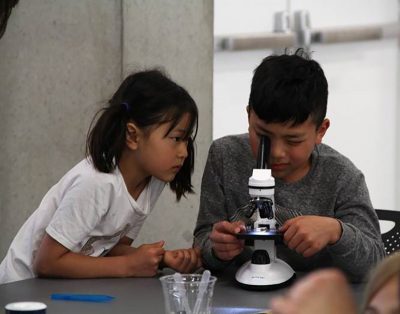Do-it-yourself science was a hit with spring breakers at The Corning Museum of Glass during the last week of April. The Museum’s Education Department hosted a MakerSpace—a place to share do-it-yourself projects, search for inspiration, and connect with fellow makers—that focused on microscopes in conjunction with the opening of the exhibition Revealing the Invisible: The History of Glass and the Microscope at the Rakow Research Library.
Visitors made microscopes out of various lenses and other materials. One example was a platform microscope made of a wooden base, two pieces of Plexiglas, some nuts and bolts, and a laser pointer lens. The specimen slide rested on a lower Plexiglas level; adjusting the height of this level adjusted the focus. The laser pointer lens was embedded in a higher Plexiglas platform, and when the smartphone’s camera was aligned perfectly with the lens, the user saw the specimen magnified on the smartphone’s screen.
With summer break right around the corner, DIY microscope projects could be a fun way to extend learning into summer activities. Here is a website to help you create your own cell phone microscope: instructables.com
- A maker stained his cheek cells red so they were more visible under the platform microscope he built. Visitors prepared specimen slides of flowers, fibers, and even insects.
- Little sister waited for her turn to use the microscope to look at a slide of a mealworm she prepared. Her brother inspected a grasshopper under the microscope.
Some of our young makers prepared their own slides using insects, flowers, sand, and even their own cheek cells. Discovering the microscopic world on their own resulted in some delighted young explorers. Learn how to prepare your own microscope slides at home.

A girl used watercolor paints to copy a photograph of a
hydra at 100x magnification. Scientists have been illustrating
what they see under the microscope since microscopes were
invented. Today, photography helps scientists share their
observations with the world.

A USB-connected microscope gave this maker a closer
look at a flower. Visitors examined their clothing, hair, and
other everyday objects with this user-friendly microscope.
Several young visitors practiced their observation skills by creating their own scientific illustrations of what they saw through the microscope. To learn more about scientific illustrations, check out the American Museum of Natural History’s Opulent Oceans website.
At the Corning Museum of Glass, we have the unique opportunity to represent glass in art and in science. Parents loved the connection to science in our MakerSpace. Kids appreciated the opportunity to tinker with different microscopes, build their own and try out new materials. We hope to host more MakerSpaces in the future to explore the connections between art and science.
CMoG’s spring break MakerSpace is generously supported by Disney, through a Creativity Garden grant, a nationwide project of the Association of Science- Technology Centers [ASTC].



